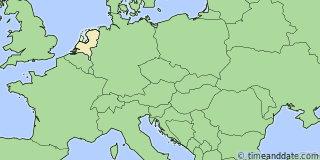Mar 30, 2025, 2:00 am
| Country: | Netherlands |
|---|---|
| Long Name: | Kingdom of the Netherlands |
| Abbreviations: | NL, NLD |
| Capital: | Amsterdam |
| Administrative Capital: | The Hague |
| Judicial Capital: | The Hague |
| Legislative Capital: | The Hague |
| Time Zones: | 2 (Main Country) |
| Total Time Zones: | 3 (with dependencies) |
| Dial Code: | +31 |
Mar 30
Forward 1 hour
Mar 30, 2025 - Daylight Saving Time Starts
When local standard time is about to reach
Sunday, March 30, 2025, 2:00:00 am clocks are turned forward 1 hour to
Sunday, March 30, 2025, 3:00:00 am local daylight time instead.
Sunrise and sunset will be about 1 hour later on Mar 30, 2025 than the day before. There will be more light in the evening and less light in the morning.
Also called Spring Forward, Summer Time, and Daylight Savings Time.
Oct 26
Back 1 hour
Oct 26, 2025 - Daylight Saving Time Ends
When local daylight time is about to reach
Sunday, October 26, 2025, 3:00:00 am clocks are turned backward 1 hour to
Sunday, October 26, 2025, 2:00:00 am local standard time instead.
Sunrise and sunset will be about 1 hour earlier on Oct 26, 2025 than the day before. There will be more light in the morning and less light in the evening.
Also called Fall Back and Winter Time.
When Does DST Start and End in the Netherlands?
The European mainland of the Netherlands uses Daylight Saving Time (DST) during part of the year. The DST period starts on the last Sunday of March and ends on the last Sunday of October, together with most other European countries.
Central European Time (CET) is used as standard time, while Central European Summer Time (CEST) is observed when DST is in force.
Which Special Municipalities, Constituent Countries and Provinces use Daylight Saving Time in 2025

Areas in Netherlands on standard time all of 2025
DST in Locations in Netherlands in 2025 (40 Locations) | |||||
|---|---|---|---|---|---|
| 's-Hertogenbosch | Mar 30 – Oct 26 | Emmen | Mar 30 – Oct 26 | Peize | Mar 30 – Oct 26 |
| Aalsmeer | Mar 30 – Oct 26 | Enschede | Mar 30 – Oct 26 | Rotterdam | Mar 30 – Oct 26 |
| Abcoude | Mar 30 – Oct 26 | Groningen | Mar 30 – Oct 26 | The Bottom | No DST |
| Alkmaar | Mar 30 – Oct 26 | Haarlem | Mar 30 – Oct 26 | The Hague | Mar 30 – Oct 26 |
| Almere | Mar 30 – Oct 26 | Hilversum | Mar 30 – Oct 26 | Tilburg | Mar 30 – Oct 26 |
| Amersfoort | Mar 30 – Oct 26 | Hoofddorp | Mar 30 – Oct 26 | Utrecht | Mar 30 – Oct 26 |
| Amsterdam | Mar 30 – Oct 26 | Leerdam | Mar 30 – Oct 26 | Vlissingen | Mar 30 – Oct 26 |
| Apeldoorn | Mar 30 – Oct 26 | Leeuwarden | Mar 30 – Oct 26 | Wageningen | Mar 30 – Oct 26 |
| Arnhem | Mar 30 – Oct 26 | Leiden | Mar 30 – Oct 26 | Woerden | Mar 30 – Oct 26 |
| Breda | Mar 30 – Oct 26 | Maastricht | Mar 30 – Oct 26 | Zaandam | Mar 30 – Oct 26 |
| Delft | Mar 30 – Oct 26 | Montfoort | Mar 30 – Oct 26 | Zoetermeer | Mar 30 – Oct 26 |
| Dordrecht | Mar 30 – Oct 26 | Nijmegen | Mar 30 – Oct 26 | Zwolle | Mar 30 – Oct 26 |
| Ede | Mar 30 – Oct 26 | Oranjestad | No DST | ||
| Eindhoven | Mar 30 – Oct 26 | Oss | Mar 30 – Oct 26 | ||
Daylight Saving Time in Dependencies of Netherlands
| Dependency | Type | Daylight Saving Time Period |
|---|---|---|
| Aruba | Constituent country | No Daylight Saving Time |
| Caribbean Netherlands | Constituent country | No Daylight Saving Time |
| Curaçao | Constituent country | No Daylight Saving Time |
| Sint Maarten | Constituent country | No Daylight Saving Time |
Daylight Saving Time History in Netherlands
- Netherlands first observed Daylight Saving Time in 1916.
- Netherlands has observed DST for 78 years between 1916 and 2024 (DST in at least one location).
- Previous time with no Daylight Saving Time was 1976.
- See Worldwide DST Statistics
One of the First Countries to Use DST
On April 30, 1916, Germany became the first country to observe Daylight Saving Time (DST). On the very next day, on May 1, 1916, the Netherlands followed suit.
Until 1940, the Netherlands' standard time was based on solar time at the meridian running through its capital, Amsterdam, instead of GMT, then the world's time standard. From 1916 to 1936, Dutch standard time was 19 minutes and 32 seconds ahead of GMT. When DST was in force, the GMT offset increased to 1 hour, 19 minutes, and 32 seconds.
During World War II, German forces ordered an all-year DST period, which lasted from 1940 to 1942. From 1942 to 1945, Dutch clocks followed Germany's DST schedule. After the country's liberation in 1945, DST was abolished. However, the Netherlands did not revert to Dutch Time but kept Central European Time (CET) as its standard time. Daylight Saving Time was re-introduced in 1977, and DST clock changes are still observed in the Netherlands to the present day.
